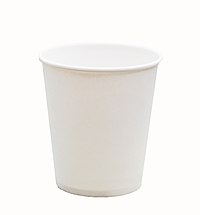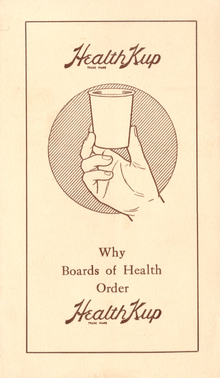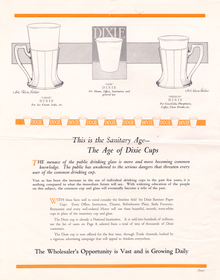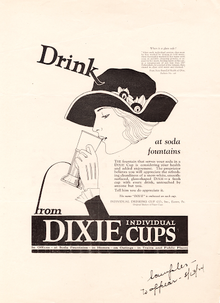How Many Cups Is A Dixie Cup


Insulated paper cup for hot drinks, cut away to show air layer
A paper cup is a disposable cup made out of paper and often lined or coated with plastic[ane] [ii] or wax to foreclose liquid from leaking out or soaking through the paper.[three] [4] It may be fabricated of recycled paper[5] and is widely used around the world.
History [edit]
Paper cups accept been documented in imperial China, where paper was invented by second century BC.[vi] Paper cups were known as chih pei and were used for the serving of tea.[7] They were constructed in dissimilar sizes and colors, and were adorned with decorative designs. Textual evidence of paper cups appears in a clarification of the possessions of the Yu family, from the urban center of Hangzhou.[7]
The modernistic paper cup was developed in the 20th century. In the early on 20th century, it was common to have shared glasses or dippers at water sources such every bit school faucets or h2o barrels in trains. This shared use caused public wellness concerns. One notable investigation into their apply was the report by Alvin Davison, biology professor at Lafayette College, published with the sensational championship "Death in Schoolhouse Drinking Cups" in Technical World Magazine in Baronial 1908, based on research carried out in Easton, Pennsylvania's public schools. The article was reprinted and distributed by the Massachusetts State Board of Health in Nov 1909.[8]
Based on these concerns, and as paper goods (especially subsequently the 1908 invention of the Dixie Cup) became cheaply and cleanly available, local bans were passed on the shared-employ cup. 1 of the get-go railway companies to use disposable paper cups was the Lackawanna Railroad, which began using them in 1909. Past 1917, the public glass had disappeared from railway carriages, replaced by newspaper cups even in jurisdictions where public glasses had yet to exist banned.[9]
Paper cups are also employed in hospitals for health reasons. In 1942 the Massachusetts State Higher found in 1 report that the cost of using washable glasses, re-used after being sanitized, was 1.6 times the cost of using single-service newspaper cups.[10] These studies, every bit well as the reduction in the take a chance of cantankerous-infection, encouraged the use of newspaper cups in hospitals.
Dixie cups [edit]
Dixie Cup is the make name for a line of dispensable paper cups that were offset developed in the U.s.a. in 1907 by Lawrence Luellen, a lawyer in Boston, Massachusetts, who was concerned about germs existence spread by people sharing glasses or dippers at public supplies of drinking h2o. Luellen developed an ice-cooled h2o-vending machine with disposable cups,[8] and with another Bostonian, Hugh Moore, embarked on an advertizing campaign to educate the public and to marketplace his motorcar, principally to railroad companies. Professor Davison'south written report was instrumental in abolishing the public glass and opening the door for the newspaper cup. Before long, the devices, which would dispense cool water for 1 cent, became standard equipment on trains.
After Lawrence Luellen invented his paper cup and corresponding h2o fountain, he started the American Water Supply Company of New England in 1908 located in Boston. The company began producing the cup likewise as the Water Vendor. In order to expand their territory, Luellen organized the American Water Supply Company of New York as well as the American Water Supply Visitor of New Jersey with the help of Hugh Moore. Instead of producing the cups and fountains, these subsidiary companies were charged with the auction and distribution of Luellen's products. In 1909 Luellen and Moore started the Public Cup Vendor Company in New York in order to lease their vendor machines. Their master customers were railroads and then that the devices could exist implemented on rider train cars. After many states started to ban the common drinking cup in public places, steady orders for Luellen's automobile began to whorl in. The success of Luellen and Moore'southward territorial companies inspired them to incorporate into the Individual Drinking Loving cup Company of New York in 1910.

Dixie Loving cup Visitor, Easton, Pennsylvania
The Dixie Loving cup was get-go called "Health Kup", just from 1919 information technology was named after a line of dolls made by Alfred Schindler's Dixie Doll Visitor in New York. Success led the company, which had existed nether a variety of names, to phone call itself the Dixie Loving cup Corporation and move to a factory in Wilson, Pennsylvania. Atop the manufactory was a large water tank in the shape of a loving cup.[11]
In 1957, Dixie merged with the American Can Company. The James River Corporation purchased American Tin's paper business in 1982. The assets of James River are at present part of Georgia-Pacific, a subsidiary of Koch Industries, the 2nd largest privately endemic company in the Us. In 1983, production moved to a mod factory in Forks, Pennsylvania. The original mill in Wilson has sabbatum vacant always since. The closing of the manufactory also prompted Conrail to carelessness the Easton & Northern railroad branch, of which Dixie Cups was the final major customer.
In 1969, the Dixie Cup logo was created by Saul Bass, a graphic designer known for his motion motion picture title sequences.
The coupon collector'southward problem is sometimes called the Dixie cup problem.
Early advertisements [edit]

Early advertisement for Dixie Cups when they were notwithstanding known every bit Wellness Kups[8]

"This is the Sanitary Age" advert for Dixie Cups[8]
The tone of many of the advertisements created by the Dixie Cup Company took the course of embracing modernistic ethics and marketing towards people who wanted to meliorate their lives and jump on lath a new tendency for fear of being left backside. "This is the sanitary age -- the age of dixie cups,"[12] was used for several years with success.
A subsequent pivot towards soda fountains was fabricated in both product line and advertising, but the central thought of individual use as more sanitary than reusable glasses persisted. An accent on the theme of cups being "touched only past you" was seen as an act to brand the cups seem individualized.

Another early ad from Dixie
Industry [edit]

The world'southward largest "paper" cup in forepart of what was in one case the Lily-Tulip manufacturing company, later Sweetheart Cup Visitor.[xiii] Fabricated of poured concrete, the loving cup stands almost 68.one anxiety (20.8 chiliad) tall.
The base of operations paper for paper cups is called "cup board", and is made on special multi-ply newspaper machines. It has a bulwark coating for waterproofing. The paper needs high stiffness and strong wet sizing. The cup lath class has a special design for the loving cup manufacturing processes. The oral cavity gyre forming procedure requires expert elongation properties of the lath and the plastic coating. A well formed oral fissure scroll provides stiffness and handling properties in the cup. The basis weights of the cup boards are 170–350 g/m2.[14]
To meet hygiene requirements, paper cups are generally manufactured from virgin (non-recycled) materials.[ citation needed ] The one exception to this is when the newspaper loving cup features an extra insulating layer for heat retentivity, which never comes into contact with the beverage, such as a corrugated layer wrapped around a single-wall cup.
Waterproofing [edit]
Originally, newspaper cups for hot drinks were glued together and made waterproof by dropping a modest corporeality of dirt in the bottom of the cup, and then spinning at high speed then that clay would travel up the walls of the cup, making the paper h2o-resistant.[ citation needed ] However, this resulted in drinks smelling and tasting of cardboard.
Cups for cold drinks could not be treated in the same way, equally condensation forms on the outside, then soaks into the lath, making the cup unstable. To remedy this, loving cup manufacturers developed the technique of spraying both the inside and outside of the cup with wax. Clay and wax-coated cups disappeared with the invention of polyethylene (PE)-coated cups; this process covers the surface of the board with a very thin layer of PE, waterproofing the board and welding the seams together.
In 2017, the Finnish board manufacturer Kotkamills launched a new kind of cup (nutrient service) board which uses no wax or plastic for waterproofing, and thus can be recycled as part of the normal paper and board waste stream, biodegraded, or even composted in modest quantities.[15]
In 2017, the Newport Beach, California, company Smart Planet Technologies, launched "reCUP" for the Uk market place, a recyclable newspaper cup using a polyethylene and mineral-blended coating branded EarthCoating, that is engineered to exist recycled through traditional paper recycling systems. Paper cups with EarthCoating are sold by Detpak, Huhtamaki, Linstol and Pureco USA.
Paper cups and paper bags made from "Pinyapel", paper made from discarded pineapple leaves, were introduced in 2019. The h2o-resistant food packaging alternative material was adult by a consortium made up of the Department of Trade and Industry Design Center of the Philippines (DCP), Cagayan de Oro Handmade Paper, Nature's Fresh, and Ideatechs Packaging Corporation. The innovation was a Wood Pencil Awardee in the 2019 edition of the annual D&Advertising Future Touch on Awards.[16] Tests by the DCP prove that the 55.32 percent mass loss of Pinyapel in four weeks is much college than the 21.33 percentage mass loss in commercial paper numberless, giving show that the material decomposes faster than other paper products.[17]
Printing on paper cups [edit]
Originally paper cups were printed using rubber blocks mounted on cylinders, with a unlike cylinder for each colour. Registration across dissimilar colours was very difficult, but later flexography plates became available and with the apply of mounting systems it became easier to register across the colours, allowing for more than complex designs. Printing flexographic has become platonic for long runs and manufacturers generally use this method when producing over a one thousand thousand cups. Machines such as Comexi are used for this, which have been adjusted to accept the extra large reels that are required by paper loving cup manufacturers. Ink technology has also changed and where solvent-based inks were being used, water-based inks are instead being utilised. One of the side effects of solvent-based inks is that hot drink cups in detail can aroma of solvent, whereas h2o-based inks accept eliminated this problem. Other methods of printing take been used for short runs such every bit starting time printing, which tin can vary from anything from ten,000 to 100,000 cups. Offset printing inks have also been developed and although in the past these were solvent based, the latest soya-based inks accept reduced the danger of cups smelling. The latest development is Direct-printing, which allows printing on very small quantities, typically from 1,000 cups, and is used past companies including Brendos Ltd offering modest quantities in short atomic number 82 times. Rotogravure can likewise be used, but this is extremely expensive and is normally only utilised for items requiring extremely loftier quality press similar water ice cream containers.
Environmental impact [edit]
Recycling [edit]
Near paper cups are designed for a single utilise and then disposal. Very little recycled paper is used to make paper cups because of contamination concerns and regulations. Since most paper cups are coated with plastic (polyethylene), and then both composting and recycling of newspaper cups is uncommon because of the difficulty in separating the polyethylene in the recycling process of said cups. As of 2016, there are only two facilities in the UK able to properly recycle PE-coated cups; in the absence of such facilities, the cups are taken to landfill or incinerated.
A UK-based business grouping James Cropper take developed the world'south first facility for the effective recycling of the estimated 2.5 billion paper java cups used and disposed of past British businesses each year, and have become one of 14 international companies to formally bring together the Paper Recovery and Recycling Group (PCRRG).[ citation needed ]
James Cropper'southward Reclaimed Fibre Facility was opened by HM The Queen in July 2013, and recovers both the plastic and newspaper from the cups; ensuring nothing is wasted from the recycling process.[18] Although paper cups are made from renewable resource (forest chips 95% by weight), paper products in a landfill might not decompose, or tin can release methane, if decomposed anaerobically.
A Newport Beach, California, company, Smart Planet Technologies has developed a new coating on newspaper cups and folding cartons called EarthCoating so they are certified universally recyclable in conventional newspaper recycling systems. Newspaper cups with EarthCoating have received the highest "AAA" rating for recycling from Der Grune Punkt (The Greenish Dot), a certifying body for recycling in the Eu, for recycling in Class 13 bales forth with office paper. Smart Planet Technologies' licensee Detpak, forth with paper-shredder Shred-X have prepare commercial recycling systems for paper cups with EarthCoating, branded "RecycleMe", used in recycled paper products such as copy paper, gift wrap, and paper bags. Detpak alleged the takeaway cup problem solved in Australia.[19] Subsequently, Australia's Department of Defense force, along with globally-recognized recycler Veolia, accept teamed upwards to recycle the department's paper cups, as part of their "War on Waste".[20]
In 2017, the Finnish board manufacturer Kotkamills launched a new kind of cup (food service) board which uses no wax or plastic for waterproofing, and thus can be recycled as part of the normal newspaper and lath waste stream, biodegraded, or even composted in small quantities.[15]
The manufacture of paper usually requires inorganic chemicals and creates h2o effluents. Paper cups may consume more not-renewable resource than cups fabricated of polystyrene cream (whose only significant effluent is pentane).[21] [22]
Paper vs plastic [edit]
A life cycle inventory of a comparing of newspaper vs plastic cups shows ecology furnishings of both with no clear winner.[23]
Polyethylene (PE) is a petroleum-based coating on paper cups that can slow down the process of biodegrading of the paper it coats.
Polylactic acrid (PLA) is a biodegradable bio-plastic coating used on some paper cups. PLA is a renewable resource and is certified compostable in industrial composting facilities, which means that when it biodegrades, it does non exit behind any toxic residues.[24] Although PLA-lined cups are the but paper cups which can be composted fully, they tin contaminate the waste stream, reportedly making other recycled plastics unsaleable.[25]
Prior to 2012, newspaper cups can but be recycled at a specialised treatment facility regardless of the lining.[26]
A number of cities – including Portland, Oregon — accept banned XPS foam cups in take-out and fast nutrient restaurants.[27]
Emissions [edit]
A study of one paper java cup with sleeve (16 ounce) shows that the CO2 emissions is about 0.253 kilograms (0.56 lb) per cup with sleeve – including paper from trees, materials, production and aircraft.[28]
Habitat-loss trees used [edit]
The habitat loss from one 16 ounce paper coffee cup with a sleeve is estimated to be 0.09 foursquare meters (0.93 square feet).[ dubious ] [29] [ unreliable source? ] Over 6.5 one thousand thousand trees were cut down to brand 16 billion paper coffee cups used past U.S. in 2006, using 4 billion US gallons (15,000,000 miii) of water and resulting in 253 million pounds (115,000,000 kg) of waste. Overall, US Americans use 58% of all newspaper cups worldwide, amounting to 130 billion cups.[18] [ unreliable source? ] [30] [ unreliable source? ]
Lids [edit]

A paper coffee cup with a plastic chapeau and "splash stick"
Newspaper cups may take various types of lids. The paper cups that are used as containers for yogurt, for example, by and large take 2 types of lids: heat-seal foil lids used for small "single serving" containers, and 150–200 ml (five–7 U.s.a. fl oz) plastic press-on, resealable lids used for large "family size" containers, 250–1,000 ml (eight–thirty US fl oz), where not all of the yogurt may be consumed at any one time and thus the ability to re-close the container is required.[31]
Hot drinks sold in paper cups may come with a plastic lid, to keep the drink hot and foreclose spillage. These lids have a hole through which the drink tin be sipped. The plastic lids can have many features including peel back tabs, raised walls to protect the cream of gourmet hot drinks and embossed text.[32] In 2008, Starbucks introduced shaped plastic "splash sticks" to block the hole, in some of their stores, afterwards customer complaints nearly hot java splashing through it.[33] [34]
References [edit]
- ^ "Take-out coffee cups may exist shedding trillions of plastic nanoparticles, study says". UPI . Retrieved 14 May 2022.
- ^ Zangmeister, Christopher D.; Radney, James G.; Benkstein, Kurt D.; Kalanyan, Berc (3 May 2022). "Common Single-Use Consumer Plastic Products Release Trillions of Sub-100 nm Nanoparticles per Liter into Water during Normal Use". Environmental Scientific discipline & Technology. 56 (9): 5448–5455. Bibcode:2022EnST...56.5448Z. doi:x.1021/acs.est.1c06768. ISSN 0013-936X. PMID 35441513. S2CID 248263169.
- ^ Kennedy, Garry: Dixie Cup entry, Apollo Glossary, NASA. Retrieved 2012-02-06.
- ^ "Newspaper Products & Dispensers". Toiletpaperworld.com. Archived from the original on 2013-02-04. Retrieved 2007-06-09 .
- ^ Raloff, Janet (2006-02-11). "Wind Makes Food Retailers Greener". Science News.
- ^ Tsien, Tsuen-Hsuin (1985). Joseph Needham (ed.). Newspaper and Press. Science and Civilisation in China, Chemistry and Chemical Technology. Vol. 5 part 1. Cambridge University Press. p. 38.
- ^ a b Joseph Needham (1985). Science and Civilisation in Cathay: Paper and Press. Cambridge Academy Printing. p. 122. ISBN978-0-521-08690-five.
At this time tea was served from baskets fabricated of rushes which held... a set of several tens of paper cups (chih pei) in different sizes and colors with delicate designs
- ^ a b c d "Dixie Cup Company History". Lafayette College Libraries. August 1995. Archived from the original on 2011-xi-12.
- ^ White, John H. (1985) [1978]. The American Railroad Passenger Car. Vol. 2. Baltimore, Maryland: Johns Hopkins University Press. p. 432. ISBN978-0-8018-2747-1.
- ^ Beulah French republic (February 1942). "Uses for Newspaper Cups and Containers". The American Journal of Nursing. 42 (ii): 154–156. doi:10.2307/3416163. JSTOR 3416163. S2CID 220566845.
- ^ Erstwhile Dixie Cup Factory, Wilson, Pa (photograph)
- ^ "Whistlin' Dixie: Marketing the Paper Loving cup, 1910-1960". sites.lafayette.edu . Retrieved 2019-05-18 .
- ^ Lily-Tulip Cup Corporation, Springfield-Greene County Library, Springfield, Missouri
- ^ Savolainen, Antti (1998). "six". Paper and Paperboard Converting. Papermaking Science and Engineering science. Vol. 12. Finland: Fapet OY. pp. 170–172. ISBN978-952-5216-12-7.
- ^ a b "Suomalainen yritys teki sen – kahvin, rasvan ja oluen kestävät muovittomat ihmepahvit lähtevät maailmalle: "Kiinnostus on valtavaa"" [A Finnish company made information technology – plastic-complimentary miracle board that tin can withstand java, fat and beer: "Nosotros have received huge interest"]. YLE. Retrieved ane September 2017.
- ^ "Pinoy-made 'Pinyapel' wins surroundings and sustainability award in New York". 30 October 2019.
- ^ "Filipinos Made This Plastic-Free Cup From Pineapple Leaves". www.vice.com.
- ^ a b "Paper Cups = Unsustainable Consumption". aboutmyplanet.com. Archived from the original on June six, 2008. Retrieved February half dozen, 2008.
- ^ "Detpak - Takeaway Loving cup Recycling Solved in Australia". www.detpak.com . Retrieved 2021-04-07 .
- ^ "Veolia and Defense join together to eliminate unmarried-use dispensable cups". Veolia Australia and New Zealand . Retrieved 2021-04-07 .
- ^ Don R. Hansen & Maryanne M. Mowen (2005). Management Accounting: The Cornerstone of Business organisation Decisions. Thomson South-Western. p. 503. ISBN978-0-324-23484-eight.
- ^ Chris T. Hendrickson; Lester B. Lave & H. Scott Matthews (2006). Environmental Life Wheel Assessment of Appurtenances and Services: An Input-output Approach. Resources for the Futurity. p. 5. ISBN978-1-933115-23-eight.
- ^ Hocking, Thou. B. (1 February 1991). "Paper Versus Polystyrene: A Complex Choice". Scientific discipline. 251 (4993n): 504–5. Bibcode:1991Sci...251..504H. doi:ten.1126/science.251.4993.504. PMID 17840849. S2CID 33293105.
- ^ "Composting". Retrieved 2013-10-15 .
- ^ "Sustainable bio-plastic can damage the environs". TheGuardian.com. 25 Apr 2008. Retrieved 2017-06-21 .
- ^ "Newspaper Cup Recycling". Retrieved 2012-02-01 .
- ^ Helfrich, Chiliad. William; Sanders, Justin Wescoat (2003-08-13). "The Coming Loving cup-tastrophe". The Portland Mercury.
- ^ "Written report of the Brotherhood for Environmental Innovation" (PDF). edf.com. Archived from the original (PDF) on 2015-09-20. Retrieved Feb 6, 2008.
- ^ "ecological effects of a paper cup". ecofx.org. Retrieved February vi, 2008.
- ^ Spitzer, Nina (xxx July 2009). "The impact of dispensable coffee cups on the environment". Retrieved 21 November 2012.
- ^ Adman Y. Tamime & Richard K. Robinson (1999). Yoghurt: science and engineering science. Woodhead Publishing. p. 97. ISBN978-ane-85573-399-two.
- ^ "The Rise of the Plastic, Dispensable Coffee Cup Lid". The Atlantic. 9 May 2011. Retrieved 3 March 2017.
- ^ "Starbucks splash stick says no to sploshing". USA Today. 14 March 2008. Retrieved 21 April 2016.
- ^ Johnson, Steve (11 March 2016). "Solving the mystery of Starbucks little light-green sticks". Chicago Tribune. Retrieved 21 Apr 2016.
Farther reading [edit]
- Allyn Freeman & Bob Golden (1997). "Picayune Dipper". Why Didn't I Call back of That? : Bizarre Origins of Ingenious Inventions We Couldn't Live Without. John Wiley and Sons. pp. 183–184. ISBN978-0-471-16511-8. – the Dixie Loving cup
- Maying Soong (2002). Chinese Paper Folding for Beginners. Courier Dover Publications. pp. 6–7. ISBN978-0-486-41806-3. – how to make a paper cup out of a foursquare of newspaper using origami
- Martin B. Hocking (November 1991). "Relative merits of polystyrene cream and paper in hot drink cups: Implications for packaging". Environmental Management. Springer New York. fifteen (6): 731–747. Bibcode:1991EnMan..15..731H. doi:x.1007/BF02394812. S2CID 137050319.
- Martin B. Hocking (Nov 1994). "Reusable and disposable cups: An energy-based evaluation". Environmental Management. Springer New York. eighteen (6): 889–899. Bibcode:1994EnMan..xviii..889H. doi:x.1007/BF02393618. S2CID 30427571.
- A mathematically annotated folding didactics for paper cups
External links [edit]
-
 Media related to Paper cups at Wikimedia Commons
Media related to Paper cups at Wikimedia Commons - Newspaper cup automobile
How Many Cups Is A Dixie Cup,
Source: https://en.wikipedia.org/wiki/Paper_cup
Posted by: arnonethintich.blogspot.com


0 Response to "How Many Cups Is A Dixie Cup"
Post a Comment